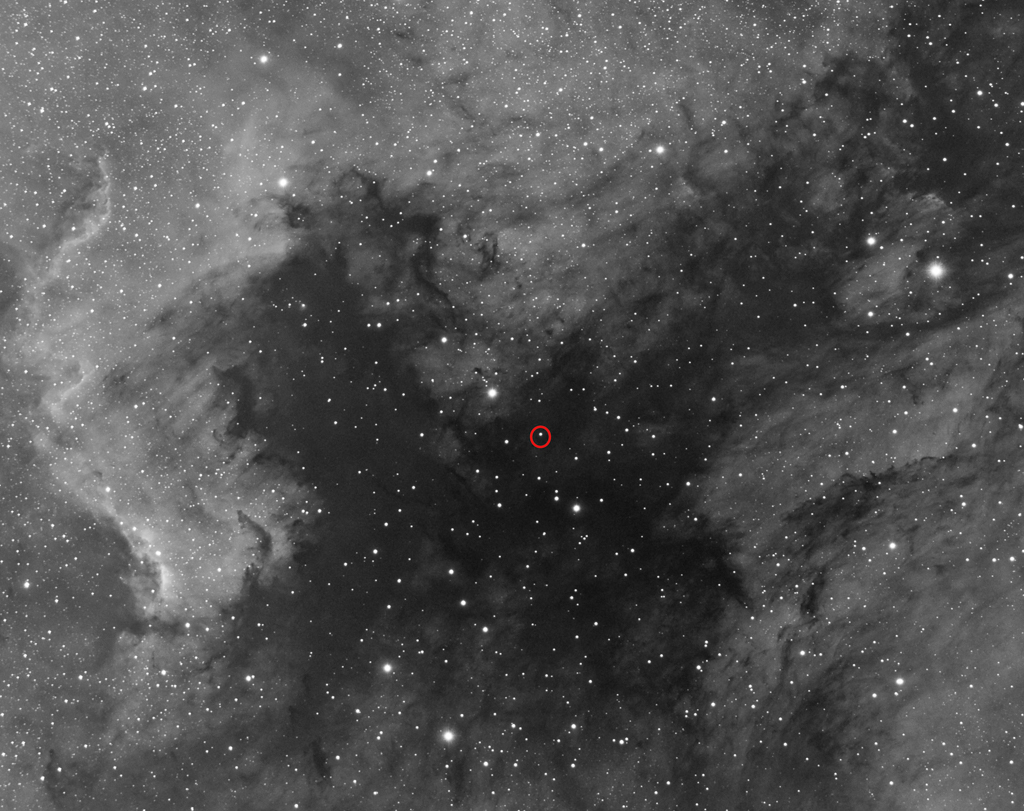Session Data
- Date: 23/06/2020
- Time: 23:01 – 23:44 UT
- Seeing: II Mostly Stable,
- Transparency: Clear,
- Temp: 13.9C,
- Air Pressure: 1021mb,
- Humidity: 92%,
- Dew Point: 12.4C,
- Wind Speed: 2mph
Scope: TMB 80mm APO Refractor at f/4.8 Camera: ZWO ASI 1600MM Pro, Filter: Ha 35nm, Processing: Dark subtracted and Flat fielded in Pixinsight.

NGC7000 ( North American nebula) and IC7070 ( Pelican nebula) – both of which are named for blindingly obvious reasons are both one single structure. The void ( L935) separating the two is a band of interstellar cloud of dust that obscures the stars behind it.

What is causing the gas in this region to Ionize has been debated for decades.
In 1922 Hubble was apparently the first to propose that nearby Deneb may be the star responsible for the ionization of the complex. However, the relatively late type of Deneb (A2Ia) soon led to the realization that the ionizing star had to be found elsewhere, and in 1952 Sharpless and Osterbrock proposed the O6V((f)) star HD199579, which is projected on the Northern part of the North America nebula, as a much more suitable candidate.
But HD199579 is not entirely convincing either: its position does not seem to be the one required to illuminate the bright rims seen scattered across the complex, and its spectral type is slightly too late to account for the nebular spectrum, which requires at least a O5 star.
Recognizing this, Herbig (1958) proposed that the actual ionizing star had to be hidden by L935. Some subsequent searches in the infrared turned up some candidates: Bally and Scoville (1980) produced a list of 11 candidates that are bright in the infrared, but their observations did not provide conclusive evidence for any of them. Around the same time, Neckel et al. (1980) identified a heavily reddened near-infrared source as the likely ionizing star, but subsequent spectroscopy by Eiroa et al. (1983) showed it to be an unrelated cool giant instead.

It wasn’t until 2004 that Fernando Comerón and Anna Pasquali using the 2.2metre telescope at Centro Astronómico Hispano-Alemán in southern Spain finally identified J205551.3+435225 as being the most likely source. This O5V star exhibits the right spectral makeup to create the ionisation found in the two nebulas and is at right distance and position, with no other similar sources in the region.
I’ve marked the culprit in Red.
The discovery raises a puzzling aspect, however. The O5V spectral type implies a mass of about 60 solar masses for J205551.3+435225, and such massive stars are well known to be gregarious, hardly ever being found in isolation. Their findings not only identify the ionizing star of the complex; they also rule out the possible existence of any other O or early B stars in the proximities of J205551.3+435225. The star is not a runaway, since proper motion measurements exist and are roughly those expected from the reflex solar motion at 600 pc in that direction.
In view of this, and of the short lives of mid O-type stars, it rather appears that J205551.3+435225 may be a rare case of a massive star formed in isolation, or at least not in company of other similarly massive stars.